Get free scan and check if your device is infected.
Remove it nowTo use full-featured product, you have to purchase a license for Combo Cleaner. Seven days free trial available. Combo Cleaner is owned and operated by RCS LT, the parent company of PCRisk.com.
What kind of malware is GhostSocks?
GhostSocks is a malicious program written in the Go programming language. It is compatible with Windows and Linux operating systems. This program is a SOCKS5 backconnect proxy malware. Essentially, software of this kind is used by attackers to employ victims' Internet connections for malicious purposes.
GhostSocks first emerged in the Autumn of 2023 in Russian hacker forums. Most of the known attacks utilizing this malware also involved the LummaC2 stealer. There is a collaborative relationship between the developers of GhostSocks and LummaC2. The backconnect proxy malware is offered as MaaS (Malware-as-a-Service) with a discount for this stealer.
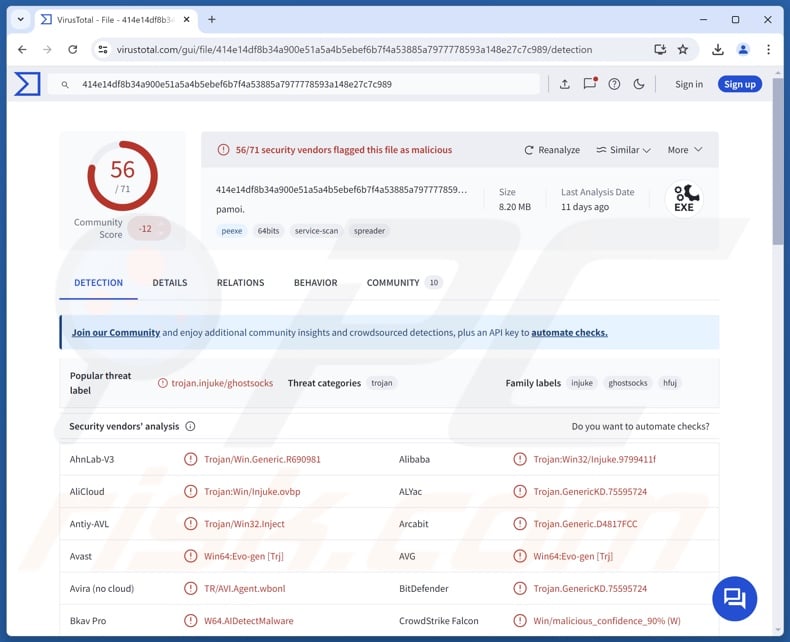
GhostSocks malware overview
GhostSocks has anti-analysis and anti-detection capabilities. It contains highly obfuscated code and can detect when executed in sandbox environments. GhostSocks operates as a SOCKS5 backconnect proxy malware.
SOCKS5 is a proxy protocol that allows network traffic to be routed through intermediary servers. Regarding the backconnect portion, the client (e.g., attacker) does not connect directly to the proxy server (e.g., victim's device) but the other way around.
In the case of backconnect malware, the cyber criminals' infrastructure is connected to by the infected machine. This is useful when interacting with external services, as the attackers can masquerade as their victims. GhostSocks functions in this manner – by creating a SOCKS5 proxy tunnel in order to route traffic via the compromised device.
To elaborate further on the practical application of hiding the origin of a connection, it enables cyber criminals to evade geolocation-based restrictions, IP-based integrity checks, and certain fraud detection mechanisms. The use of GhostSocks in combination with the LummaC2 stealer sheds more light on the possible goal of these infections.
This data-stealing malware targets log-in credentials and 2FA/MFA (Two/Multi-Factor Authentication) codes used by various services, information linked to cryptocurrency wallets, and other sensitive information. The data acquired by LummaC2 can be used with greater success by utilizing GhostSocks.
Many high-sensitivity services (like those dealing with finances) employ various mechanisms and verification processes to prevent fraudulent/malicious activities – and GhostSocks can be used to bypass them.
GhostSocks has other capabilities; it can modify SOCKS5 credentials, execute shell commands, and download/run executables. The last one means this program could introduce additional malicious components or malware into systems.
In theory, this functionality may be used to cause any type of infection (e.g., trojans, ransomware, etc.). However, in practice, software capable of causing chain infections can only do so within certain limitations or specifications.
To summarize, the presence of GhostSocks on devices can lead to multiple system infections, severe privacy issues, financial losses, and identity theft.
| Name | GhostSocks virus |
| Threat Type | Trojan, backconnect proxy malware. |
| Detection Names | Avast (Win64:Evo-gen [Trj]), Combo Cleaner (Trojan.GenericKD.75595724), ESET-NOD32 (A Variant Of Win64/GenKryptik.HFUJ), Kaspersky (Trojan.Win32.Injuke.osan), Microsoft (Trojan:Win32/Multiverze), Full List Of Detections (VirusTotal) |
| Symptoms | Trojans are designed to stealthily infiltrate the victim's computer and remain silent, and thus no particular symptoms are clearly visible on an infected machine. |
| Distribution methods | Infected email attachments, malicious online advertisements, social engineering, software 'cracks'. |
| Damage | Stolen passwords and banking information, identity theft, the victim's computer added to a botnet. |
| Malware Removal (Windows) |
To eliminate possible malware infections, scan your computer with legitimate antivirus software. Our security researchers recommend using Combo Cleaner. Download Combo CleanerTo use full-featured product, you have to purchase a license for Combo Cleaner. 7 days free trial available. Combo Cleaner is owned and operated by RCS LT, the parent company of PCRisk.com. |
Malware in general
Malware is a broad term covering programs with various capabilities. Malicious software can be designed for a narrow purpose or be incredibly multi-functional. It is not limited to its classification either (e.g., data stealing abilities are common in general), and malware is often used in tandem with other malignant programs.
Prevalent functionalities include: infiltrating malicious software (backdoors/loaders), injecting malicious code into processes/software (injectors), enabling remote access to machines (RATs), encrypting data or locking screens for ransom purposes (ransomware), exfiltrating information from systems/apps (stealers), stealing/replacing clipboard content (clippers), recording keystrokes (keyloggers), recording audio/video via microphones/cameras (spyware), abusing system resources to generate cryptocurrency (cryptominers), and so on.
It must be emphasized that regardless of how malware operates – its presence on a system endangers device integrity and user safety. Therefore, all threats must be eliminated immediately upon detection.
How did GhostSocks infiltrate my computer?
Since GhostSocks is offered for sale, it could be distributed by relying on different methods depending on the cyber criminals using this malware. Malicious software is usually disguised as or bundled with regular programs/media.
Infectious files come in various formats, e.g., executables (.exe, .run, etc.), archives (RAR, ZIP, etc.), documents (Microsoft Office, Microsoft OneNote, PDF, etc.), JavaScript, and so forth. Merely opening a virulent file can be enough to trigger malware download/installation.
Phishing and social engineering are standard in malware distribution. Widespread methods include: backdoor/loader trojans, drive-by downloads, online scams, malicious attachments/links in spam mail (e.g., emails, PMs/DMs, etc.), malvertising, dubious download channels (e.g., freeware and third-party sites, Peer-to-Peer sharing networks, etc.), illegal software activation tools ("cracks"), and fake updates.
What is more, some malicious programs can self-proliferate via local networks and removable storage devices (e.g., external hard drives, USB flash drives, etc.).
How to avoid installation of malware?
It is essential to be vigilant when browsing since fraudulent and dangerous online content usually appears legitimate and harmless. We recommend treating incoming emails and other messages with caution. Attachments or links present in suspect/irrelevant mail must not be opened, as they can be malicious.
Another recommendation is to download only from official and verified sources. Additionally, all programs must be activated and updated using legitimate functions/tools, as those obtained from third-parties can contain malware.
It is paramount for device/user safety to have a dependable anti-virus installed and kept updated. Security software must be used to run regular system scans and to remove detected threats and issues. If you believe that your computer is already infected, we recommend running a scan with Combo Cleaner Antivirus for Windows to automatically eliminate infiltrated malware.
Instant automatic malware removal:
Manual threat removal might be a lengthy and complicated process that requires advanced IT skills. Combo Cleaner is a professional automatic malware removal tool that is recommended to get rid of malware. Download it by clicking the button below:
DOWNLOAD Combo CleanerBy downloading any software listed on this website you agree to our Privacy Policy and Terms of Use. To use full-featured product, you have to purchase a license for Combo Cleaner. 7 days free trial available. Combo Cleaner is owned and operated by RCS LT, the parent company of PCRisk.com.
Quick menu:
- What is GhostSocks?
- STEP 1. Manual removal of GhostSocks malware.
- STEP 2. Check if your computer is clean.
How to remove malware manually?
Manual malware removal is a complicated task - usually it is best to allow antivirus or anti-malware programs to do this automatically. To remove this malware we recommend using Combo Cleaner Antivirus for Windows.
If you wish to remove malware manually, the first step is to identify the name of the malware that you are trying to remove. Here is an example of a suspicious program running on a user's computer:
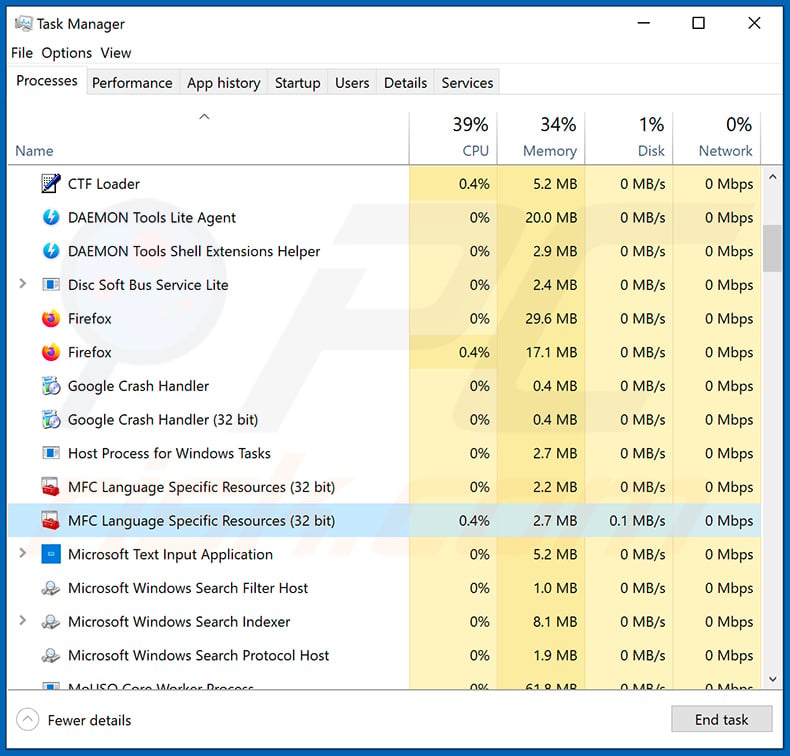
If you checked the list of programs running on your computer, for example, using task manager, and identified a program that looks suspicious, you should continue with these steps:
 Download a program called Autoruns. This program shows auto-start applications, Registry, and file system locations:
Download a program called Autoruns. This program shows auto-start applications, Registry, and file system locations:
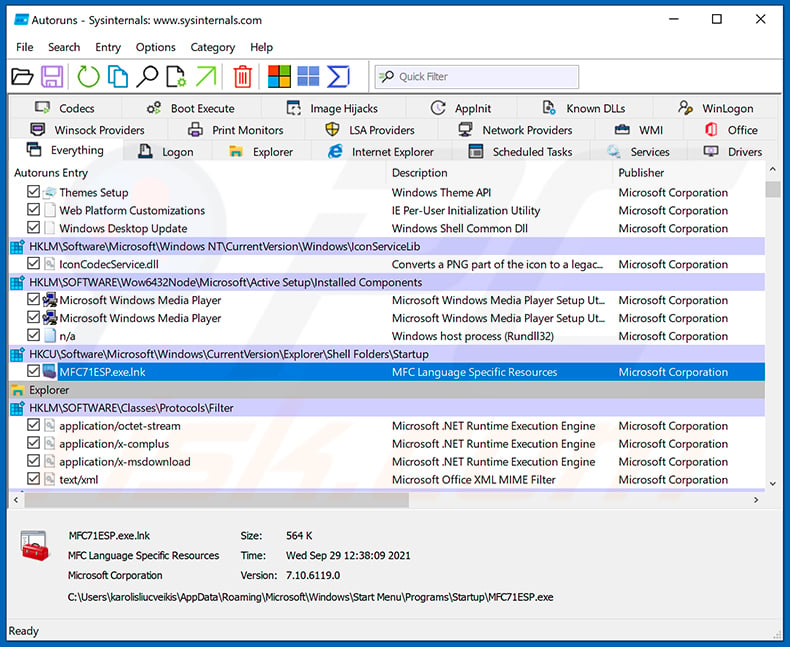
 Restart your computer into Safe Mode:
Restart your computer into Safe Mode:
Windows XP and Windows 7 users: Start your computer in Safe Mode. Click Start, click Shut Down, click Restart, click OK. During your computer start process, press the F8 key on your keyboard multiple times until you see the Windows Advanced Option menu, and then select Safe Mode with Networking from the list.
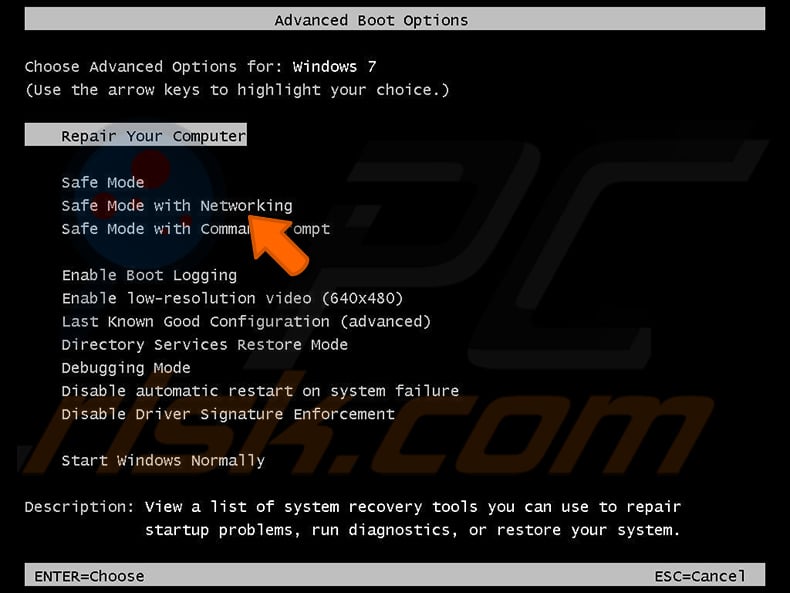
Video showing how to start Windows 7 in "Safe Mode with Networking":
Windows 8 users: Start Windows 8 is Safe Mode with Networking - Go to Windows 8 Start Screen, type Advanced, in the search results select Settings. Click Advanced startup options, in the opened "General PC Settings" window, select Advanced startup.
Click the "Restart now" button. Your computer will now restart into the "Advanced Startup options menu". Click the "Troubleshoot" button, and then click the "Advanced options" button. In the advanced option screen, click "Startup settings".
Click the "Restart" button. Your PC will restart into the Startup Settings screen. Press F5 to boot in Safe Mode with Networking.
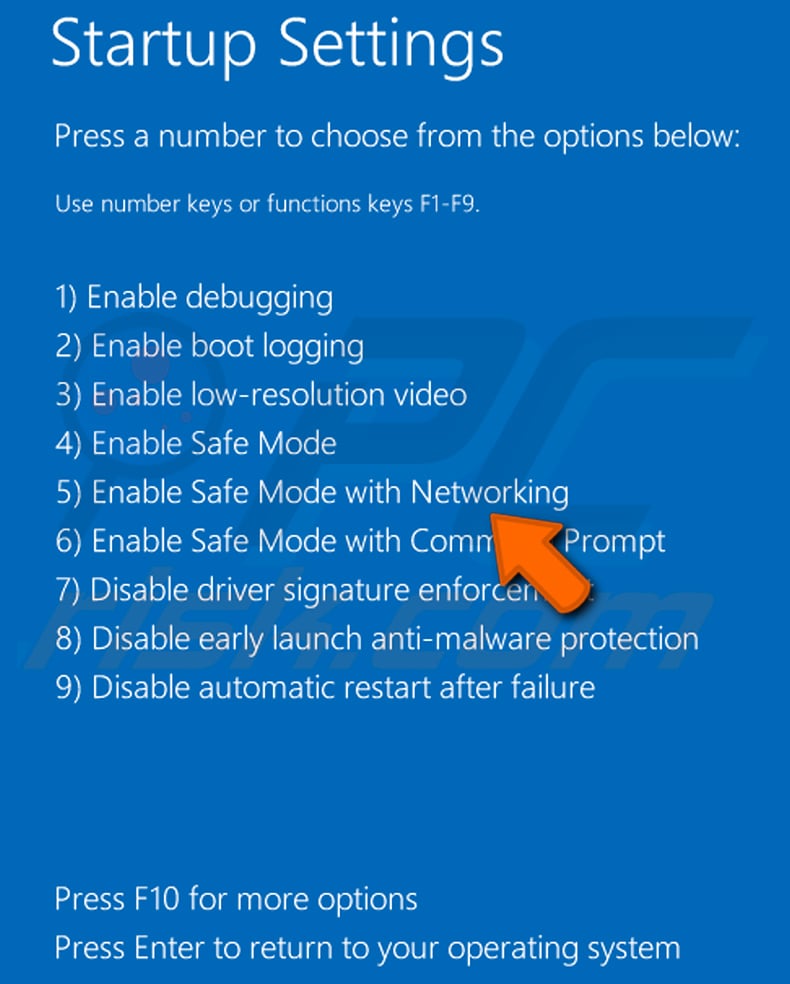
Video showing how to start Windows 8 in "Safe Mode with Networking":
Windows 10 users: Click the Windows logo and select the Power icon. In the opened menu click "Restart" while holding "Shift" button on your keyboard. In the "choose an option" window click on the "Troubleshoot", next select "Advanced options".
In the advanced options menu select "Startup Settings" and click on the "Restart" button. In the following window you should click the "F5" button on your keyboard. This will restart your operating system in safe mode with networking.
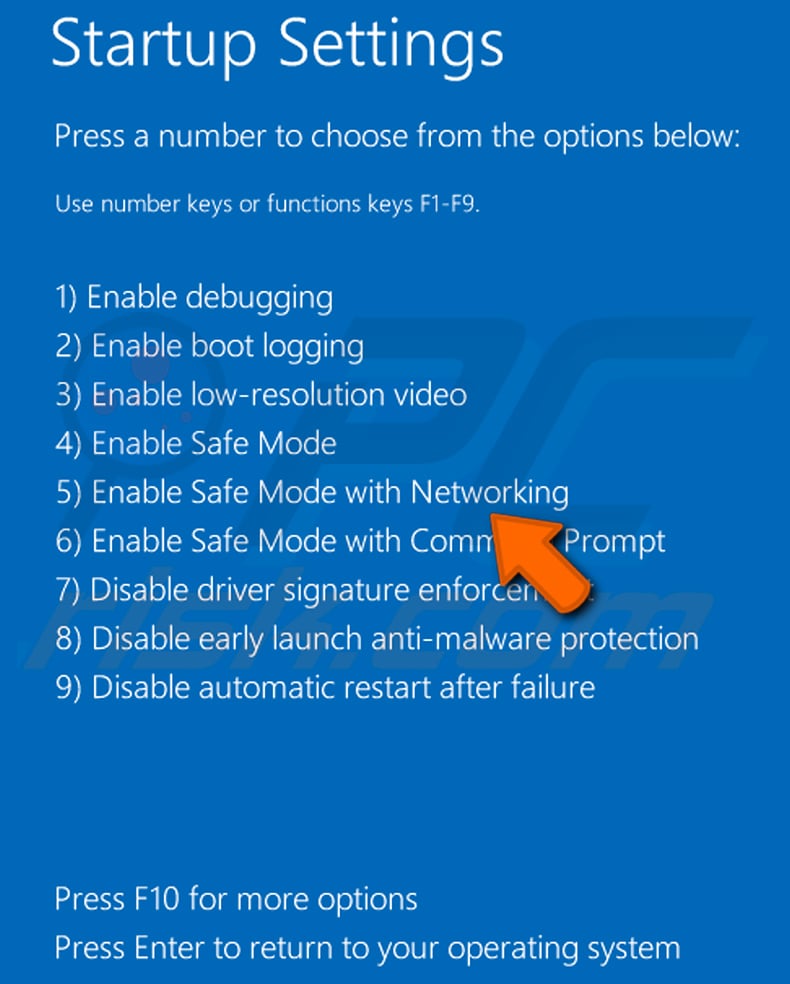
Video showing how to start Windows 10 in "Safe Mode with Networking":
 Extract the downloaded archive and run the Autoruns.exe file.
Extract the downloaded archive and run the Autoruns.exe file.
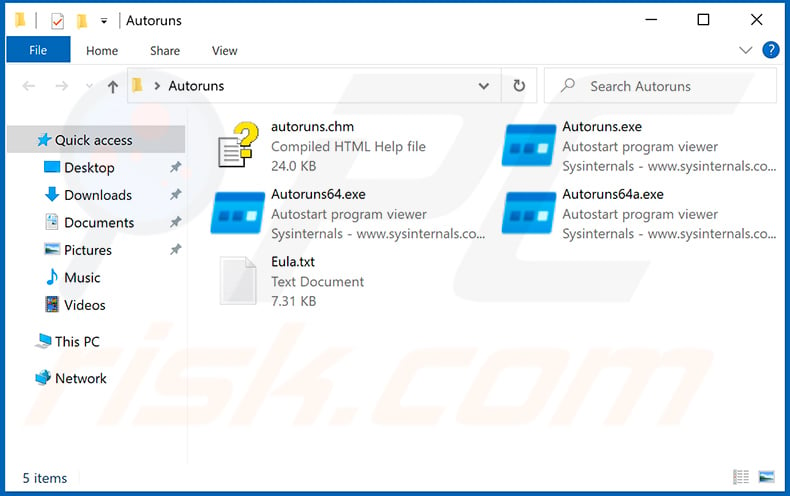
 In the Autoruns application, click "Options" at the top and uncheck "Hide Empty Locations" and "Hide Windows Entries" options. After this procedure, click the "Refresh" icon.
In the Autoruns application, click "Options" at the top and uncheck "Hide Empty Locations" and "Hide Windows Entries" options. After this procedure, click the "Refresh" icon.
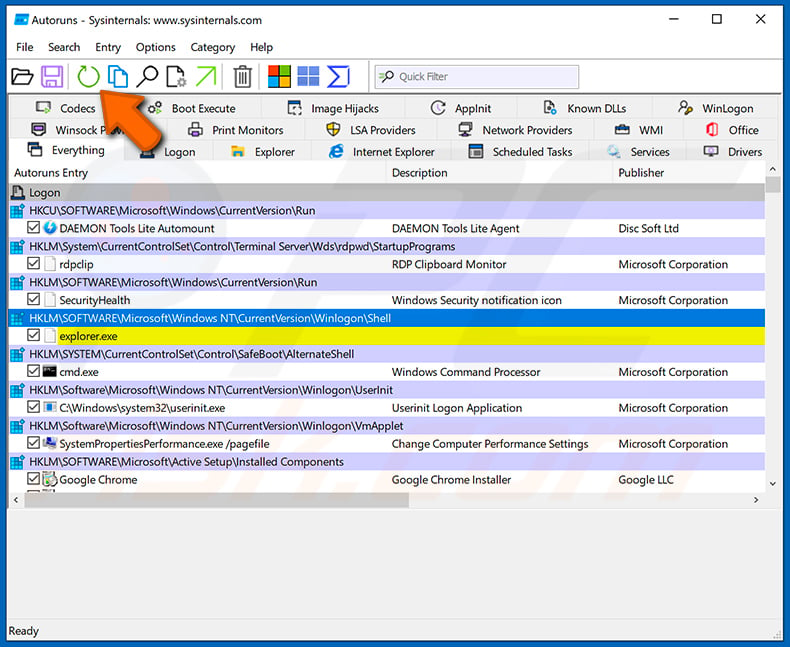
 Check the list provided by the Autoruns application and locate the malware file that you want to eliminate.
Check the list provided by the Autoruns application and locate the malware file that you want to eliminate.
You should write down its full path and name. Note that some malware hides process names under legitimate Windows process names. At this stage, it is very important to avoid removing system files. After you locate the suspicious program you wish to remove, right click your mouse over its name and choose "Delete".
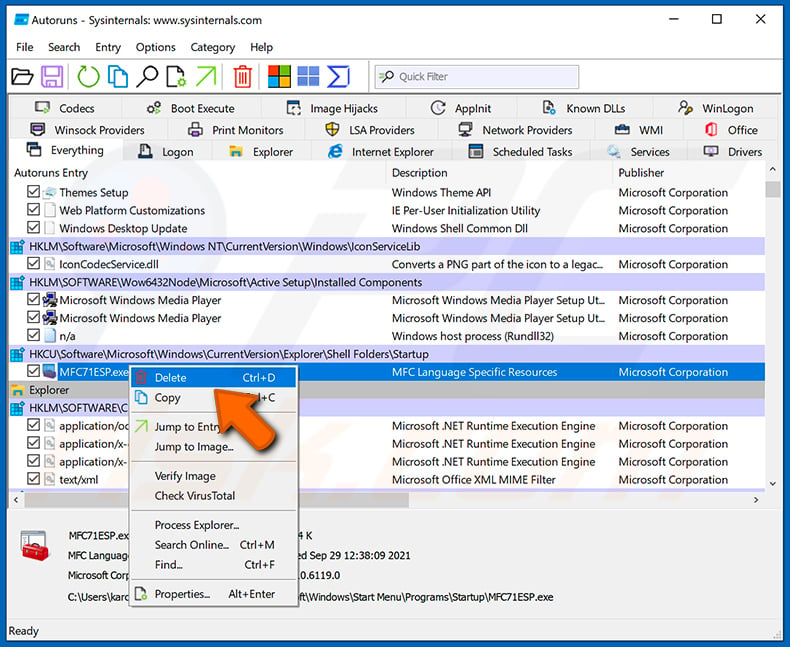
After removing the malware through the Autoruns application (this ensures that the malware will not run automatically on the next system startup), you should search for the malware name on your computer. Be sure to enable hidden files and folders before proceeding. If you find the filename of the malware, be sure to remove it.
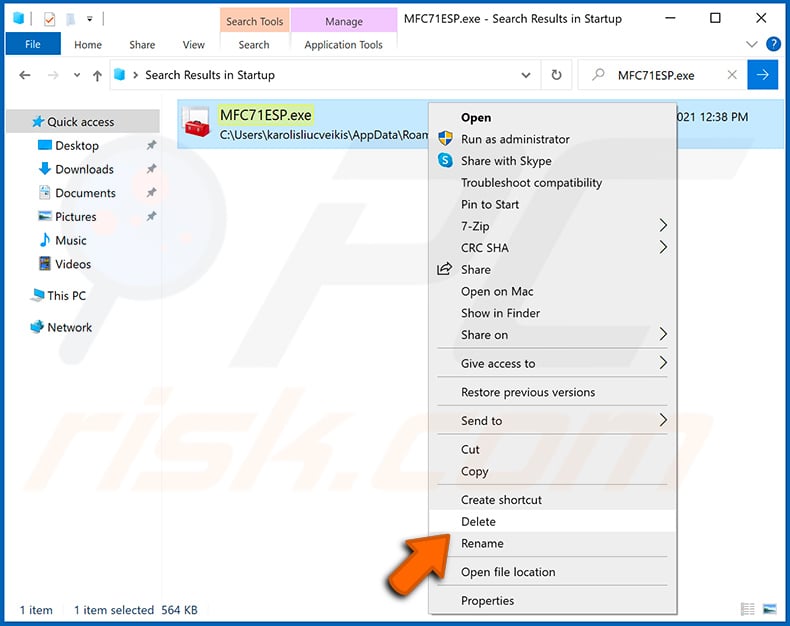
Reboot your computer in normal mode. Following these steps should remove any malware from your computer. Note that manual threat removal requires advanced computer skills. If you do not have these skills, leave malware removal to antivirus and anti-malware programs.
These steps might not work with advanced malware infections. As always it is best to prevent infection than try to remove malware later. To keep your computer safe, install the latest operating system updates and use antivirus software. To be sure your computer is free of malware infections, we recommend scanning it with Combo Cleaner Antivirus for Windows.
Frequently Asked Questions (FAQ)
My computer is infected with GhostSocks malware, should I format my storage device to get rid of it?
Malware removal rarely needs such drastic measures.
What are the biggest issues that GhostSocks malware can cause?
The dangers posed by an infection depend on the program's capabilities and cyber criminals' modus operandi. GhostSocks is a backconnect proxy malware that allows attackers to route traffic through infected systems. It is often used alongside the LummaC2 stealer.
Hence, credentials acquired by the stealer can be successfully used with GhostSocks disguising the activity as coming from the victim (e.g., for facilitating financial operations, etc.). GhostSocks may cause multiple system infections, serious privacy issues, monetary losses, and identity theft.
What is the purpose of GhostSocks malware?
Profit is the most common motivation behind malware attacks. However, the attackers may also use malicious software to amuse themselves, realize personal grudges, disrupt processes (e.g., sites, services, companies, etc.), engage in hacktivism, and launch politically/geopolitically motivated attacks.
How did GhostSocks malware infiltrate my computer?
Malware is primarily spread through trojans, drive-by downloads, suspicious download channels (e.g., freeware and third-party websites, P2P sharing networks, etc.), online scams, malvertising, spam emails/messages, illegal software activation ("cracking") tools, and fake updates. Furthermore, some malicious programs can self-proliferate via local networks and removable storage devices.
Will Combo Cleaner protect me from malware?
Combo Cleaner is designed to scan devices and remove all kinds of threats. It is capable of detecting and eliminating most of the known malware infections. Note that performing a full system scan is essential since sophisticated malicious programs tend to hide deep within systems.
Share:

Tomas Meskauskas
Expert security researcher, professional malware analyst
I am passionate about computer security and technology. I have an experience of over 10 years working in various companies related to computer technical issue solving and Internet security. I have been working as an author and editor for pcrisk.com since 2010. Follow me on Twitter and LinkedIn to stay informed about the latest online security threats.
PCrisk security portal is brought by a company RCS LT.
Joined forces of security researchers help educate computer users about the latest online security threats. More information about the company RCS LT.
Our malware removal guides are free. However, if you want to support us you can send us a donation.
DonatePCrisk security portal is brought by a company RCS LT.
Joined forces of security researchers help educate computer users about the latest online security threats. More information about the company RCS LT.
Our malware removal guides are free. However, if you want to support us you can send us a donation.
Donate
▼ Show Discussion